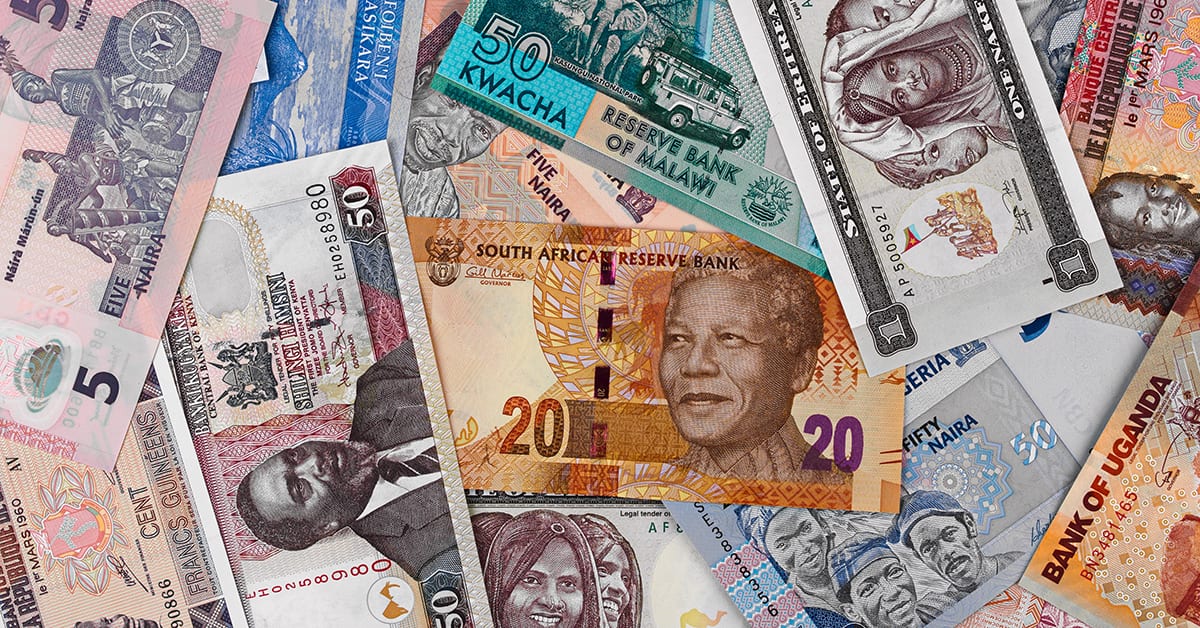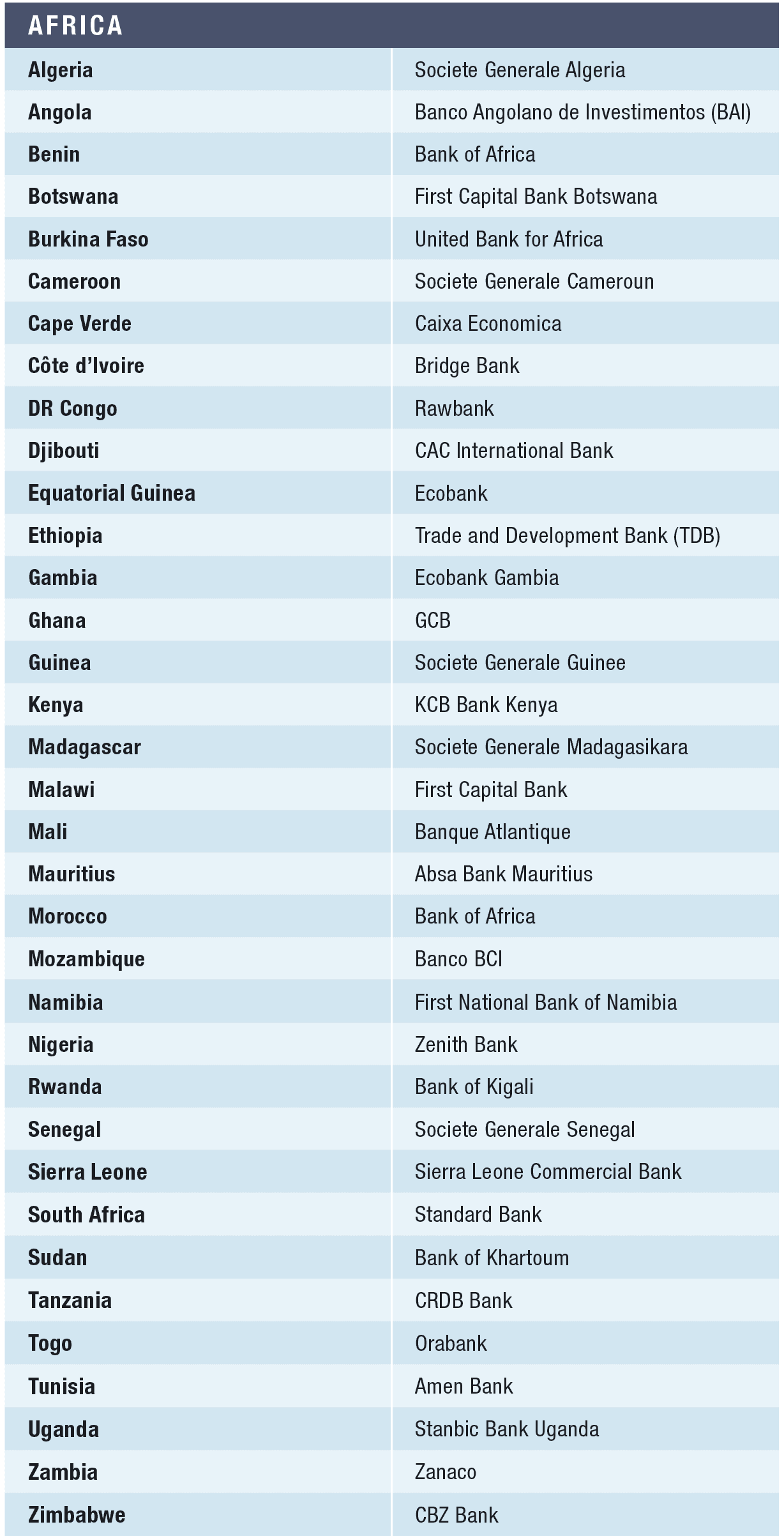Africa’s Best Banks adapted to help clients and communities.

History has shown that necessity breeds innovation, particularly during crisis. For African banks, 2020 was a year to demonstrate the ability to innovate, due to unprecedented disruptions brought about by Covid-19. The pandemic undoubtedly wreaked havoc on economies. The banking sector was not spared, suffering a surge in nonperforming loans (NPLs) and a plunge in profitability.
In late March, McKinsey reported that the average return on equity (ROE) for African banks had fallen to 7% in 2020, from 14% in 2019, which is at least better than their counterparts in developed markets, where McKinsey estimates average ROE could dip below 1.5% in 2021. Rebound for Africa’s banking industry could be swift and could return to near precrisis levels within the next three years, largely because banks “acted boldly to manage the economic fallout of the pandemic,” says McKinsey.
By all accounts, African banks have been innovative in response to various looming threats to human existence, the pandemic being only the latest. “The pandemic reinforced the value of several traditional aspects of good banking practice,” says Sim Tshabalala, Standard Bank Group CEO. This includes the importance of understanding client needs and prudent risk management.
Putting safety of people first accelerated the shift toward digitalization. Online and mobile banking are the new normal in service delivery. Across the continent, top banks are in a race to digitalize to remain ahead. More telling, industry laggards have become late believers.
“Banking today is digital,” observes Joshua Oigara, KCB Bank Kenya’s Group CEO. Today, 98% of KCB Bank transactions are conducted outside the branch.
For Standard Bank, 99% of transactions in South Africa are digital, as are 95% of transactions in its other African markets. Besides, more than 75% of its employees work remotely. “We have found that this has worked well, and we expect this experience to have lasting effects,” adds Tshabalala.
It is against the changing face of banking that Global Finance is unveiling the 2021 edition of the Best Banks in Africa. Despite the Covid-19 induced stress, the best banks on the continent have demonstrated resilience and remain optimistic for a quick recovery. There is little evidence the pandemic has forced banks to halt their precrisis growth strategies, particularly ambitions to expand to new markets across the continent. While pan-African banks like Standard Bank, Ecobank, Societe Generale and Bank of Africa want to cement their position, homegrown banks like KCB and Zenith are implementing aggressive strategies for expansion.
Regional Standout
For the second year in a row, Standard Bank has emerged as the Best Bank in Africa as well as Best Bank in South Africa. This comes against the backdrop of a tough year for the group, which operates in 20 markets on the continent. On March 11, the group released its 2020 full-year results reflecting severe battering by Covid-19 related impacts. Headline earnings declined by 43% to $1 billion from $1.8 billion in 2019, with ROE falling to 8.9% from 16.8%.
The situation was dire in its home market in South Africa. Here, the bank maintained its position as Best Bank despite an environment characterized by stiff competition and an economy that was deep in crisis even before Covid-19. During the year, Standard Bank saw its headline earnings plunge by a substantial 65% to $328.3 million from $944.8 million, while ROE declined from 26.3% to 9%. Outside South Africa, it was no different though less acute. Earnings declined by 32% and ROE to 6.9%.
Maintaining strong capital buffers despite being forced to restructure $10.3 billion worth of loans, and increasing provisions by 43%, allowed Standard Bank to remain upbeat. “We remain confident that the continent will continue to grow rapidly over the medium and long term,” says Tshabalala. For this reason, the group intends to continue offering a comprehensive range of financial solutions supplemented by ancillary and additional services in its home market. Across Africa, the focus is on expanding the range of services and solutions, growing market share and being on the lookout for attractive partnerships or acquisition opportunities.
Those priorities are the clear focus on the continent is well projected by Stanbic Bank Uganda, the Best Bank in that country. Despite a profitability decline, Stanbic remained steadfast that it will continue to support key sectors of the economy, including agriculture, manufacturing, utilities, transport and small and midsize enterprises (SMEs). Speaking at a press conference, Anne Juuko, Stanbic Bank Uganda CEO, said, “The emergence of oil and gas will create vast opportunities for the local economy, and our role as a bank is to provide financial solutions to clients across the entire value chain, especially local companies looking to participate in the sector.”
Multi-Country Winners
Societe Generale, despite having its roots in Europe, has never hidden its strong ambitions for Africa. Frédéric Oudéa, Societe Generale Group CEO, reckons Africa is a key market in the bank’s growth strategy. This is underpinned by the continent’s entrepreneurial ecosystem and a vibrant private sector. “Our long history with Africa is rooted in the financing of the real economy,” he says. He adds that, due to its commitment to the continent, Societe Generale will continue supporting development in a responsible manner.
With operations in 19 countries and four million customers, Societe Generale ranks among the top three banks in many of the markets, and came out a winner in Algeria, Cameroon, Guinea, Madagascar and Senegal.
In Algeria, Societe Generale navigated a tough period over the past two years, characterized by political uncertainty and Covid-19, to continue innovating and transforming. “Despite the election of a new president with the hope of reinvigorating the economy in 2019, the pandemic dashed expectations of a rebound,” notes Eric Wormser, CEO of Societe Generale Algeria. Irrespective of the challenging environment, the bank, which serves 150,000 customers, continues to demonstrate agility despite a decline in profitability and ROE by 20% and 24%, respectively.
In Cameroon, although facing stiff competition, particularly from other lenders focused on West Africa, Societe Generale Cameroun increased its branches to 38 from 35 to serve its customers, growing beyond 211,000 in number despite a 13.5% decline in profitability in 2019.
Societe Generale takes pride in being the bank of the mining sector and commands substantial market share in trade finance, with more than 28% in letters of credit and 20% in international remittances, key to Societe Generale Guinee’s win.
On the island nation of Madagascar, Societe Generale Madagasikara boasts of solidity, with 63 branches, 272,000 clients, $736.4 million in assets, 41% ROE and 29% market share in loans and deposits. The bank is a key player in financing sectors like energy and agriculture and is also committed to supporting SMEs.
A history dating back to 1962 has seen Societe Generale Senegal become the top bank in the country. The bank is determined to cement its market dominance by harnessing digital channels such as mobile banking to reach the unbanked and maintain its position as a major player in financing the national economy, particularly in areas like infrastructure and trade.
West Africa
West Africa emerged as a region where banks are fiercely competing for the loyalty of customers. This is with good reason. The region is rich in terms of its population that stands at around 412 million people, according to World Population Review. However, financial inclusion remains relatively low at 55% according to the African Development Bank. With efforts ongoing to push the rate to 75% by 2025, banks see opportunities to grow their retail business.
More critically, being a diverse region with a mix of middle-income and low-income countries also ignited an unprecedented competition for corporate clients. In fact, winning and holding onto clients in sectors like services, oil and gas, manufacturing, government, mining, wholesale and trading, telecoms and construction have become cutthroat.
In the region, pan-African Ecobank emerged as the Best Bank in Equatorial Guinea and Gambia. In Equatorial Guinea, the bank is implementing a digital transformation strategy to not only enhance service delivery but also capture new customers. The bank, which is keen to boost women entrepreneurs, is looking to exploit opportunities in targeting remittances and financing trade and agriculture sectors.
Ecobank Gambia, whose assets in 2019 stood at $180.5 million and which posted $5.6 million in profits, believes mobile channels offer the best bet for growth, particularly in reaching rural populations.
In Benin, Bank of Africa showed that cultivating a niche market brings success. The bank, whose core focus is the SME sector, is a market leader in customer deposits at 25% and boasts of assets in excess of $1.7 billion.
United Bank for Africa is among the lenders battling to grow their presence on the continent. The Best Bank in Burkina Faso has built a reputation there for customer service, and deployed digital solutions that are anchoring its growth.
Though majority owned by the state, Caixa Economica has proven national banks can compete with private banks. With over 360,000 customers, $833.6 million in assets, $10 million in profits and 20.1% ROE, the bank is the winner in Cape Verde.
Innovation and risk management have been central in Bridge Bank’s success in Côte d’Ivoire. In 2020, the bank saw its balance sheet hit the $1 billion mark. With 30% growth in net profits, 24% ROE and 1% ratio of NPLs, the bank has embarked on regional expansion after securing approval to operate in Senegal.
In November last year, John Kofi Adomakoh was appointed managing director of GCB in Ghana. His brief, according to the board, is to steer the bank’s transformation journey and further strengthen its position in growing market share, revenue and profits. The bank has a strong foundation, with $12.6 billion in assets, $15 million profit increase in the first half of 2020 and 9.3% in NPLs.
Banque Atlantique, our Best Bank in Mali, revamped its technology infrastructure for heightened security in transactions and is moving ahead with strategies geared toward digital solutions.
Zenith Bank maintained its position as the Best Bank in Nigeria amid stiff competition in Africa’s most populous nation. With a staggering $20.6 billion in assets and $1.3 billion in gross earnings, the bank is shaking the industry with innovations like blockchain, the cloud, robotics and artificial intelligence, among others.
State-owned Sierra Leone Commercial Bank emerged the winner in Sierra Leone. The bank is committed to financial inclusion and has been rolling out online and mobile banking to reach more clients.
In Togo, Orabank is leveraging the digital revolution to offer innovative financial services to over 115,000 customers in a market where it controls over 20% market share in loans and deposits.
Southern Africa
Banco Angolano de Investimentos (BAI) is the winner in Angola. With $3.6 billion in assets and 1.2 million customers, the bank is a key financier of the oil and gas sector, which is key to Angola’s economy.
The Best Bank in Botswana, First Capital Bank Botswana, saw its assets grow by 27% and is making significant inroads in mobile and internet banking.
Absa Bank Mauritius is the winner in Mauritius. With strong ratings and 17% ROE, the bank launched Abby, its “first humanoid robot,” and supported Omnicane Group (one of its large, local corporate clients) to fully implement SWIFT for security, cost savings and efficiency.
In Mozambique, Banco BCI maintained steady growth in assets and controlled substantial market share in loans and deposits. The bank is focused on growth, with two new branches and investment in IT.
First National Bank of Namibia saw its profits decline by 23.2% but remains well grounded in terms of capital, liquidity and other fundamentals. It has a market capitalization of $578 million.
In Zambia, Zanaco saw its loan book hit $341 million and income rise to $105.9 million. The bank is determined to grow its retail business with entry into microfinance. In Zimbabwe, the rapid growth of CBZ Bank, which controls about a third of banking industry deposits, is sending shockwaves through the banking sector, with ROE reaching a record 121%.
Northern Africa
Bank of Africa, which operates in 20 African countries, is the Best Bank in Morocco. The bank plays an important role in some of the continent’s most important investment projects. The bank boasts of $35.3 billion in assets and was the rst Moroccan bank to open a representative ofce in China to facilitate trade.
In Sudan, Bank of Khartoum is the winner. The bank offers Shariah-compliant financial services and is the oldest in the country, with a wide branch network of over 140. Amen Bank, yet again, emerged the Best Bank in Tunisia. With $3.3 billion in assets and 9.8% growth in ROE, the bank is committed to digital transformation to drive growth.
East Africa
In the East African region, home-grown lenders have demonstrated their shrewdness, with pan-African and global banks largely unable to dethrone them from their ruling position.
Global Finance’s winner in Djibouti is CAC International Bank. The first bank in the country to introduce e-banking and mobile banking posted an 18% growth in assets to $398 million and 16% growth in ROE, while NPLs remained relatively low at 6%.
Trade and Development Bank (TDB), the winner in Ethiopia, is focused on funding private sector projects. The bank, whose core mandates are fostering trade, development and integration, boasts $7 billion in assets.
KCB Bank Kenya, which is aggressively expanding regionally through acquisitions, maintained its position as the Best Bank in Kenya despite recording a 22% decline in profits to $177.2 million last year. “Acquisitions in these markets will buttress our leadership position and give us a stronger edge,” notes CEO Oigara.
In Rwanda, Bank of Kigali’s tight grip on the market is evident. With 68 branches, the bank serves 600,000 customers in a country of 13 million people. This has seen the bank, whose assets stand at $1.2 billion, control 16% market share.
Tanzania’s Best Bank, CRDB Bank, harbors ambitions to expand to more countries after opening a subsidiary in Burundi. With 243 branches, the bank is strong in retail and SME banking. Loans to SMEs stood at $1.7 billion in 2020. The bank boasts of $3 billion in assets and 17.5% ROE.
Central Africa
Rawbank is Global Finance’s choice in the Democratic Republic of the Congo. With $2.1 billion in assets, the bank is strong on retail and SME financing. With over 40 branches, Rawbank is the market leader in terms of deposits and has been instrumental in infrastructure finance.
Our Best Bank in Malawi, First Capital Bank boasts of $1.1 billion in assets and a $450 million loan book. With a network of 32 branches and 500,000 customer bases, the bank sees digital transformation as the anchor for future growth.




